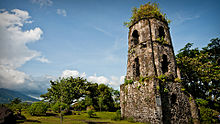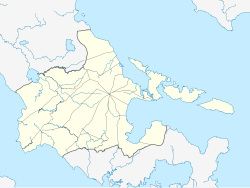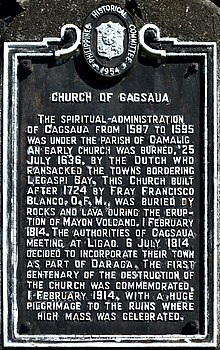| Rugba nin Cagsawa | |
 Only the church tower and the walls remains the Cagsawa Church, which was destroyed by the 1814 eruption of Mayon Volcano Only the church tower and the walls remains the Cagsawa Church, which was destroyed by the 1814 eruption of Mayon Volcano | |
   | |
| Alternative name | Kagsawa, Cagsaua |
|---|---|
| Location | Barangay Busay, Daraga, Albay, Bicol Region, Philippines |
| Coordinates | 13°9′58″N 123°42′4″E / 13.16611°N 123.70111°E / 13.16611; 123.70111 |
| Type | Church |
| Area | 500 m (5,400 sq ft) |
| History | |
| Builder | Franciscan order |
| Founded | 1724 |
| Abandoned | 1814 |
| Management | Local government of Daraga and the National Museum of the Philippines |
The Cagsawa Ruins (also spelled as Kagsawa, historically spelled as Cagsaua) are the remnants of a 16th-century Franciscan church, the Cagsawa church. It was originally built in the town of Cagsawa in 1587 but was burned down and destroyed by Dutch pirates in 1636. It was rebuilt in 1724 by Fr. Francisco Blanco but was destroyed again, along with the town of Cagsawa, on February 1, 1814, during the eruption of Mayon Volcano.
The ruins are currently located in Barangay Busay, Cagsawa, in the municipality of Daraga, Albay, Philippines. It is part of Cagsawa Park, is protected and maintained by the municipal government of Daraga and the National Museum of the Philippines, and is one of the most popular tourist destinations in the area. The Internationale Tourismus-Börse Berlin, one of the world's top travel trade shows based in Berlin, has even recognized the site as one of the places to visit in Asia. A preliminary excavation of the Cagsawa ruins by the Bulacan State University, show that the Spanish incorporated Mesoamerican influences in constructing the complex.
Location
The Cagsawa ruins are located 2.2 km (1.4 mi) from the town of Daraga and are approximately 8 km (5.0 mi) from the city of Legazpi. They are also 3.3 km (2.1 mi) from the Legazpi Airport and a 55-minute flight from Manila. By bus, the location is 12 to 14 hours away from Manila.
It is considered symbolic of the dangers of living in close proximity with Mt. Mayon, as it is situated roughly 11 kilometres (6.8 mi) away from the volcano.
History

The baroque church of Cagsawa was originally built in 1587 in the small town of Cagsawa (spelled as Cagsaua during the Hispanic era in the Philippines). The church, however, was burned down by Dutch pirates on July 25, 1636. In 1724, the church was rebuilt by Franciscan friars under Father Francisco Blanco.
See also: Mayon Volcano § Recorded eruptionsOn February 1, 1814, the strongest eruption recorded to date of the Mayon volcano buried the town of Cagsawa and its surrounding areas under several hundred million cubic meters of tephra and lahar, killing an estimated 2,000 people. Hundreds of inhabitants of the town of Cagsawa purportedly sought refuge in the church, but were also killed by pyroclastic flows and lahar. Only the belfry and some parts of the convent survive today, though parts of the crumbling facade were still standing long after the 1814 eruption as attested by photographs. It is believed that the facade of the structure collapsed due to earthquakes that hit the area in the 1950s.
Survivors of the 1814 eruption resettled into the nearby Daraga, which was then a mere barrio of the destroyed town of Cagsawa, and decided to merge the two. However, the Cagsawa church should not be confused with the intact church of Nuestra Señora de la Porteria (locally known as the Daraga Church), built in 1773 and also located in the municipality of Daraga.
Cagsawa was also subjected to the Super Typhoon Durian (designated Typhoon Reming by PAGASA) in 2006. The ruins were unharmed even as the typhoon devastated the surrounding countryside with mudslides and lahar that killed at least 1,266 people. The incident is similar to another catastrophe in the same region in 1825, shortly after the 1814 Mayon eruption.
Tourism

The ruins of the Cagsawa church now stands as the site of the Cagsawa Ruins Park, one of the most popular tourist destinations in Albay. It is also the site of the Cagsawa Branch of the National Museum of the Philippines, also known as the Cagsawa National Museum. The museum was established on land that was donated by the municipality of Daraga to the National Museum on January 26, 1981.
It was formally inaugurated on October 30, 1992, and is the third largest regional branch of the National Museum. It houses a collection of photographs of the volcanic eruptions of Mount Mayon as well as various geological and archeological exhibits.
In addition, Cagsawa also provides all-terrain-vehicle (ATV) tours which allow tourists to trail down the lava front in Barangay Mabinit.
Cagsawa Festival
The Cagsawa Festival is the latest addition to the celebrated festivals of Albay province, and has recently joined the ranks of the province's major festivals. It was launched in 2012 by the province and the municipal government of Daraga. The festival showcases various activities and entertainment such as outdoor and sport events, culinary activities, and cultural presentations of dances and plays.
In line with this, the Pintura Cagsawa was also introduced, which provides venue for artists to showcase their works through body painting. It is solely on this festival in the province that body art is explored and showcased.
Last February 1, 2014, the province of Albay commemorated the 200th anniversary of the 1814 eruption by holding the Cagsawa Festival, “Cagsawa Dos Siglos.” The festival aimed to pay tribute to the strength and resiliency of the people in Albay. According to Joey Salceda, Albay governor, Albayanos (local name for people from Albay,Philippines) are aware that they live within the shadow of a beautiful yet dangerous volcano every day. Thus, the anniversary of the 1814 eruption also serves as a reminder of the town's commitment to disaster risk reduction as part of their way of life to be able to achieve their goals of development for the community.
References
- "ITB Berlin". Messe Berlin. Retrieved May 3, 2014.
- Preliminary Results of Archaeological Investigation in Cagsawa Ruins in Albay, Philippines: Sacred Spaces Archaeology By: Angel Sarmiento Recto, Reynaldo Ramos Avellana, Evangelina Ramos Recto (Page 13)
- Henrylito D. Tacio (February 15, 2011). "Legaspi: Home of Natural Wonders". Manila Bulletin. Retrieved April 7, 2011.
- Chris Rowthorn; Greg Bloom; Michael Grosberg; Ryan Ver Berkmoes (2006). Lonely Planet Philippines. Lonely Planet; 9th Edition. ISBN 978-1-74104-289-4.
- "Cagsawa Ruins – A Legacy to the Bicolanos". Philippines Insider. Retrieved April 7, 2011.
- ^ "Cagsawa Branch Museum". National Museum of the Philippines. Retrieved April 7, 2011.
- ^ England, Vaudine (December 24, 2009). "Mount Mayon: a tale of love and destruction". BBC News. Retrieved December 25, 2009.
- National Historical Institute (1994). Historical Markers: Region V-XII. Ermita, Manila: National Historical Institute. p. 16. ISBN 971-538-069-7. Retrieved March 3, 2020.
- ^ Albert Speer (1967). "Plaque on church steeple, Cagsawa ruins, Philippines, (1967 picture)". Eruption of Mt Lamington, Papua New Guinea, 1951. National Library of Australia. Retrieved April 7, 2011.
- "Overview of the Region: Province of Albay, Where To Go And What To See". Department of Tourism, National Statistical Coordination Committee – Regional Division V, Republic of the Philippines. Archived from the original on September 21, 2016.
- "Mayon". Global Volcanism Program, Department of Mineral Sciences, National Museum of Natural History, Smithsonian Institution. Retrieved April 7, 2011.
- CP David (September 17, 2014). "What kinds of volcanic eruption should we worry about?". GMA News. Retrieved September 25, 2014.
- John Mark Escandor (July 3, 2014). "1814 Mayon Volcano eruption emits lesson on handling challenge of destruction". Balita. Retrieved September 25, 2014.
- ^ Jaymee T. Gamil (March 23, 2008). "Young tour guides bring depth to Cagsawa experience". Inquirer. Retrieved April 7, 2011.
- "Mt Mayon Volcano Eruption, 1814". Fabulous Philippines. Retrieved April 7, 2011.
- Jaucian, Michael. "Tourism execs cry SOS for Cagsawa ruins". Philippine Daily Inquirer. Retrieved January 2, 2015.
- Jaymee T. Gamil. "History of Daraga". Parish Church of Nuestra Senora de la Portera. Retrieved April 7, 2011.
- "The Cagsawa ruins". NewsBreak: Independent Journalism. December 20, 2006. Retrieved April 7, 2011.
- Emily B. Bordado (2006). "Rummaging through the ruins of Typhoon Reming". UMAsenso. 15 (4). Department of Agriculture RFU 5. Archived from the original on August 12, 2011.
- Rey M. Nasol. "Cagsawa Shrine to showcase Mayon Volcano for New 7 Wonders of the world". Positive News Media. Retrieved April 7, 2011.
- Amo, Celso (February 3, 2014). "Albay welcomes Chinese tourists". The Philippine Star. Retrieved May 3, 2014.
- Tribune (January 19, 2014). "Cagsawa Festival 'Dos Siglos' to recall 1814 Mayon eruption". The Daily Tribune. Retrieved May 3, 2014.
- Magtoto, Raymond (March 6, 2014). "Depicting Cagsawa through body art". Philippine Daily Inquirer. Retrieved May 3, 2014.
- Barcia, Rhaydz (February 1, 2014). "Worst Mayon eruption remembered". Retrieved May 3, 2014.
External links
 Media related to Cagsawa Ruins at Wikimedia Commons
Media related to Cagsawa Ruins at Wikimedia Commons- Cagsawa National Museum Official Site
| Philippine Registry of Cultural Property (PRECUP) | ||
|---|---|---|
| Government cultural agencies | ||
| Categories of cultural properties | ||
| Related | ||